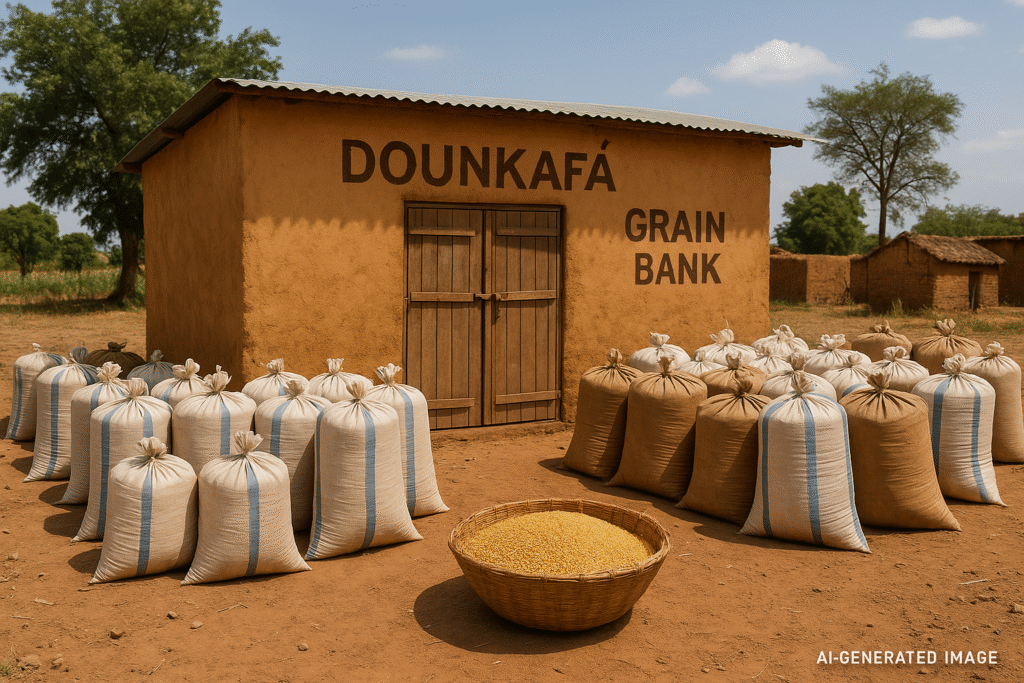
The Problem and Motivation Behind
“Our main objective is to fight against food insecurity… We mostly target local framers because they are the ones who face the most difficulties during harvest time. They run here and there to finance their activities, sometimes taking loans that they can hardly pay back.” – Bibata Maiga
Bibata Maiga (25-year-old) and his team grew up Ségou region in Mali,wherethey witnessed firsthand how local famers, despite working hard to cultivate their crops, often struggled to afford the very food they produced. Many local farmers face difficulties during the harvesting period, as they lack the necessary funds to finance their agricultural activities. Often, they are forced to take high-interest loans from banks, leaving them with minimal profit after repaying debts.
The Innovative Solution
“Our solution is a grain bank that finances local producers and provides them with a storage to store their harvest when prices are low. That way, they will be able to stabilise food prices and reduce framers’ vulnerability … If the rice is sold per kilogram at 500 CFA, we can sell it to vulnerable people at 400 or even 350 …” – Bibata.
When Bibata and his team joined the Youth Innovation Lab, they chose to address the problem food insecurity in their region. They found out that 1.2 million people in the region struggle to access affordable and nutritious food. Through a Design Thinking process, they began by listening to local farmer and their stories of struggle during the harvest season. After clearly defining the problem as a lack of affordable storage and financing options, they brainstormed potential solutions. They decided on a grain bank model to support the community during food shortages. They then moved on to prototyping a model for their solution.
Their grain bank model DOUNKAFÁ has two support schemes
- Supporting local farmers – Farmers receive training in farming techniques to increase yield, as well as inputs (like seeds and fertiliser) in advance, and after the harvest, the costs are deducted — making it easier to grow without needing a loan. Then, farmers commit to selling their harvest back to DOUNKAFÁ, which builds up the DOUNKAFÁ’s food storage, to sell farmers’ harvest gradually, avoiding the pressure to sell immediately at low prices.
- Support vulnerable families – With food in stock, DOUNKAFÁ sells it at reduced prices to those in need (e.g. 350–400 CFA instead of the usual 500 CFA per kg). The grain bank also serves as a buffer stock for vulnerable people during periods of scarcity. To identify eligible families to get this support. DOUNKAFÁ will partner with the Social Development Department that have data about people in need for support.
During testing their model, they gathered feedback from both farmers and community leaders, seeing it as a practical way to address food scarcity while also supporting local agriculture. Their feedback proved that this model of community grain banks can contribute to combating food insecurity, along with enhancing local famers’ agriculture techniques to ensure a more productive harvest.
Lessons Learned and Addressing Challenges
“The lab taught us how to work as a team and co-create new ideas. We learned that sometimes, the best solutions come from combining our thoughts rather than sticking to preconceived ideas.” – Bibata Maiga
The Youth Innovation Lab helped Bibata and his team to understand the importance of community engagement and collaborative problem-solving. Initially, some team members were unsure about the feasibility of creating a grain bank, but the lab provided insights into Design Thinking and project planning, allowing them to build a more structured and practical approach. The lab also taught the team to adapt their mindset and think from the perspective of the people they are helping.
One significant challenge has been securing financial support. Despite having a well-developed plan, their solution is still a prototype, requiring 34 million CFA francs (about $57,000) to establish the grain bank and conduct training workshops for farmers. The team remains motivated but recognises that funding is crucial to moving forward. “The motivation is there, and the skills are there. What we need is financial support because our project is a social one that requires significant investment to make a real difference.” – Bibata explains.
Next Steps and Future Aspirations
“We are determined to make DOUNKAFA a long-term solution. Our goal is to establish the grain bank, support local farmers, and ensure that vulnerable people can access food at reduced prices.” – Bibata.
Bibata and his tram envisions DOUNKAFA not just as a local initiative but as a scalable model for other regions in Mali. By showcasing the success of their approach, they aim to inspire other youth groups to take on similar challenges. Their next steps include securing funding, setting up the grain bank infrastructure, and training local farmers in sustainable farming practices. The team also plans to establish partnerships with local government agencies to streamline the identification of vulnerable households.